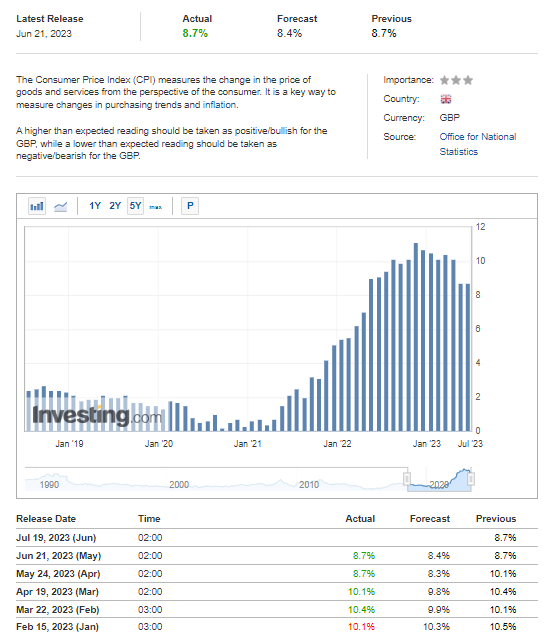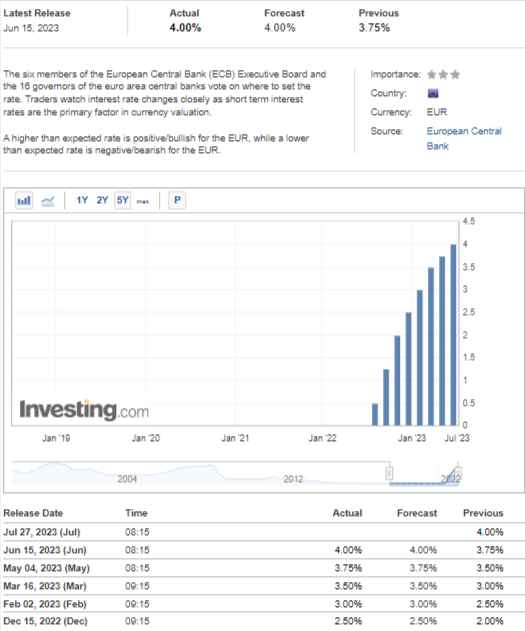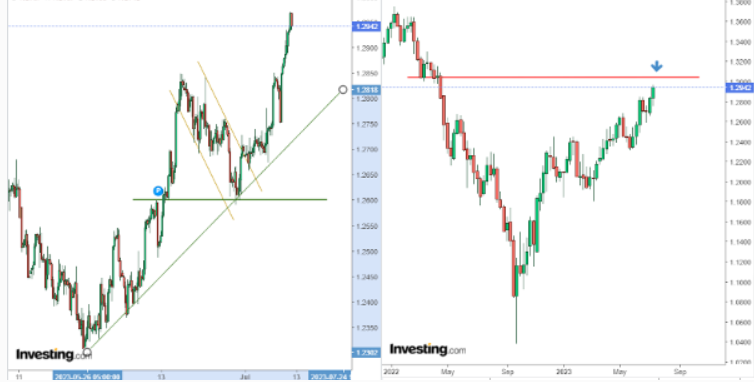- U.K. inflation is highest among G7 countries and inflation in Eurozone is expected to stay elevated until 2025
- This is set to ensure a hawkish policy until inflation is under control
- Meanwhile, GBP/USD has broken out, with 1.30 looking likely soon
The European Central Bank and the Bank of England, the two key central banks in Europe, have announced their intention to maintain a hawkish monetary policy. The Bank of England's decision is primarily driven by the high inflation figures, which reached 8.7% year-on-year (consumer) and 7.1% year-on-year (core) based on May readings. Consequently, the Bank of England authorities have no option but to consider raising interest rates significantly, potentially up to 6.5%.
The situation in the eurozone appears slightly better, with consumer inflation at 5.5% year-on-year. However, Christine Lagarde and other members of the Governing Council emphasize that there is still substantial work to be done to bring inflation down to the targeted level. According to the latest forecasts from Allianz Trade, it is expected that inflation will only reach the desired range in 2025.
U.K.'s Flurry of Poor Data
The U.K. has recently experienced a series of unfavorable data, particularly regarding inflation. These inflation figures leave no room for doubt about the Bank of England's future monetary policy.

It's important to highlight that since March, all the readings have consistently exceeded the forecasts. This is especially concerning when considering core inflation, which continues to show an upward trend. However, in the case of consumer inflation, it seems that the peak may have already passed.
In addition to the concerning inflation data, there's also the issue of the wage growth rate, which was published on Tuesday. Once again, it surprised on the upside and remained at relatively high levels, further complicating the fight against excessive price growth.
These developments pose significant challenges in terms of combating inflationary pressures and maintaining stable economic conditions.

Source: Investing.com
In just a week, on Wednesday, we will receive crucial data on the Consumer Price Index (CPI), which will greatly impact the Bank of England's decision at its upcoming meeting. The current outlook suggests that the monetary tightening trend will continue.
ECB to Persist With High Rates
The recent European Central Bank (ECB) forum held in Sintra, Portugal, left no room for doubt regarding monetary policy. Central bankers convened to discuss the challenges posed by high inflation.
The prevailing consensus among the speakers was the necessity to persist with raising interest rates, which are expected to remain elevated until the end of 2024. ECB President Christine Lagarde highlighted the robust labor market, which continues to support the economy and stave off the threat of a recession. This provides leeway for further interest rate hikes. In essence, her message can be summarized as follows:
"We have made significant progress, but given the enduring nature of inflation, we must not hesitate, as there is still a considerable journey ahead of us."
As a result, we should anticipate another 25-basis-point increase at the forthcoming meeting, bringing interest rates to levels last seen in 2008. Notably, this achievement will be reached at a notably faster pace.

GBP/USD Breaks Out
The GBP/USD pair remains on an upward trajectory, extending the trend that began in late September and early October of the previous year. Over the past few days, we witnessed an acceleration in the pair's movement, primarily influenced by a relatively weaker U.S. dollar, driven in part by the latest data from the U.S. labor market, as well as hawkish expectations regarding the Bank of England's policy.
On the demand side, there has been a notable breakout from a local correction phase, fueled by a robust surge in demand. As a result, the focus now shifts towards targeting the supply zone positioned around the 1.30 price level.

It is likely that the pair might attempt to breach the mentioned level; however, caution is advised due to the presence of a strong supply in that area. This could lead to a potential short-term rebound or resistance. However, looking at the medium-term perspective, the pressure for further upward movement in the GBP/USD pair is expected to persist.
Disclaimer: This article was written for informational purposes only; it does not constitute a solicitation, offer, advice, counsel, or recommendation to invest, nor is it intended to encourage the purchase of assets in any way.
